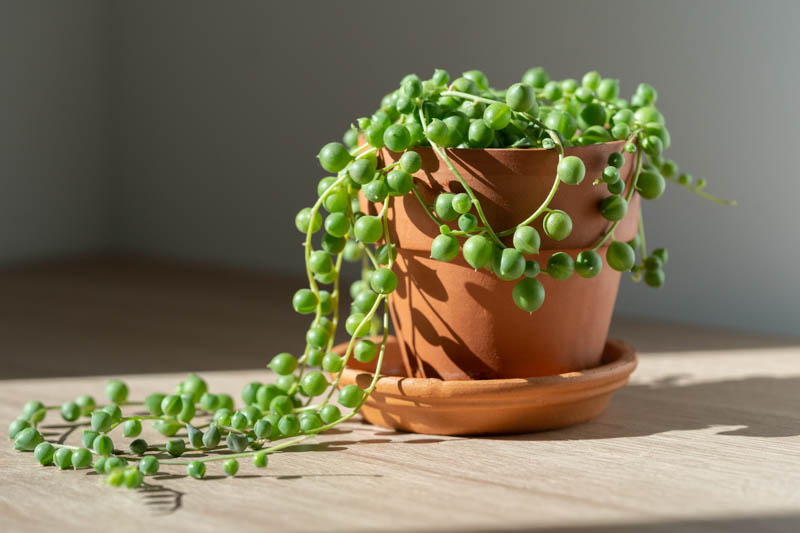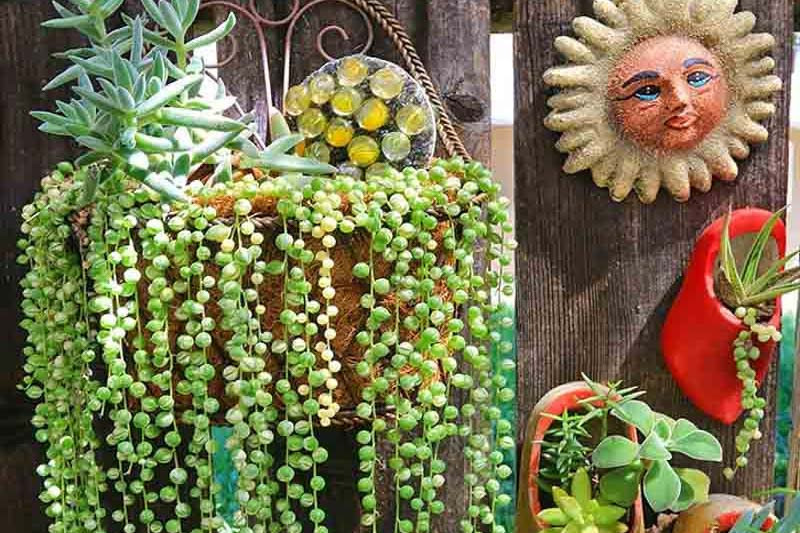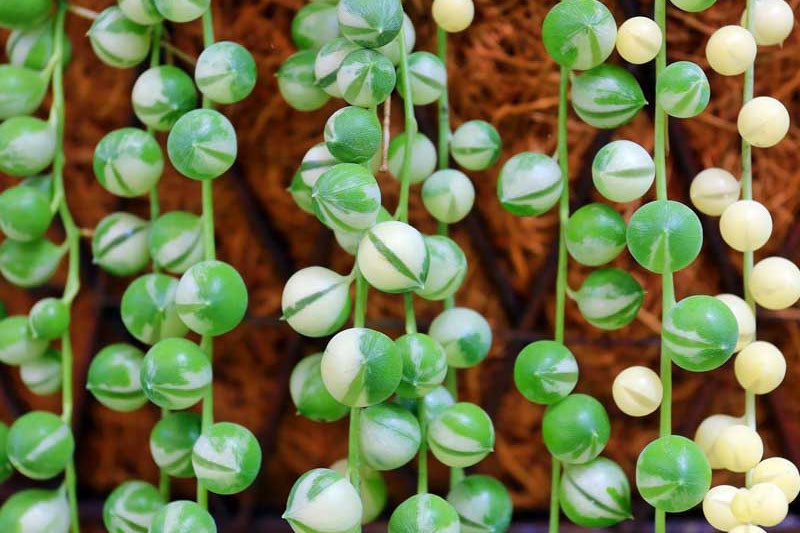String of Pearls, String of Beads
String of Pearls (Senecio rowleyanus) is a popular trailing succulent known for its unique bead-like leaves and trailing growth habit. It is native to southwestern Africa and is a member of the Asteraceae family.
Description: The plant features small, spherical, pea-shaped leaves that resemble a string of pearls or beads, hence the name. The leaves are green and store water, making the plant drought-tolerant. The stems can trail up to 2-3 feet (60-90 cm) long.
Growth habit: String of Pearls has a cascading growth habit, with trailing stems making it an excellent choice for hanging baskets or as a trailing accent in mixed containers. It grows relatively quickly under the right conditions.
Flowers: String of Pearls produces small, creamy-white daisy-like flowers adorned with long red stamens and bright yellow anthers. While not showy, the flowers have a sweet and spicy cinnamon scent.
Blooming season: The plant usually blooms during the cooler months, from late fall to early spring.
Hardiness: String of Pearls is not frost-tolerant and is best suited for USDA hardiness zones 9-12. In colder climates, it can be grown as a houseplant or moved indoors during winter.
Uses: String of Pearls is ideal for hanging baskets, window boxes, or mixed containers. It can also be used as a ground cover in frost-free climates.
Pollinators: The plant’s flowers attract various pollinators, such as bees and butterflies.
Toxicity: String of Pearls is considered mildly toxic to pets (cats and dogs) and humans if ingested. Keep it out of reach of pets and children.
Deer and rabbit resistance: The plant is not a preferred food source for deer or rabbits, making it relatively resistant to grazing.
Drought tolerance: String of Pearls is highly drought-tolerant, thanks to its water-storing leaves. It is also heat-tolerant and fire-resistant.

String of Pearls (Senecio rowleyanus) is a unique and visually striking plant that stands out for several reasons:
Unusual appearance: The bead-like, spherical leaves of the String of Pearl plant resemble a string of green pearls or beads, giving the plant a distinctive appearance that attracts attention and adds visual interest to any space.
Trailing growth habit: The cascading stems of the String of Pearls can reach lengths of several feet. This trailing habit creates a dramatic, cascading effect that can enhance the aesthetics of your indoor or outdoor garden.
Easy care: As a succulent, this plant is drought-tolerant and requires relatively low maintenance. It can thrive with infrequent watering and well-draining soil, making it an ideal choice for busy plant enthusiasts or those who prefer low-maintenance plants.
Air-purifying properties: Like many other houseplants, String of Pearls can help improve indoor air quality by absorbing certain pollutants and releasing oxygen. This makes it not only visually appealing but also beneficial for your living environment.
Fragrant flowers: Although String of Pearls is primarily grown for its unique foliage, it also produces small flowers that emit a sweet, cinnamon-like fragrance. The flowers add an extra layer of charm to this already intriguing plant.
These special features make the String of Pearl plant an attractive and interesting addition to any indoor or outdoor garden space, and its low-maintenance nature makes it accessible to plant enthusiasts of all skill levels.

Growing and caring for String of Pearls indoors is relatively easy, as they are low-maintenance plants. Here are some guidelines to help your plant thrive indoors:
Light: String of Pearls prefers bright, indirect light. Place the plant near a south, east, or west-facing window with plenty of filtered sunlight. Avoid direct, harsh sunlight, which can cause the leaves to scorch.
Soil: Use well-draining soil, preferably a cactus or succulent mix. This soil type ensures that excess water drains away from the roots, reducing the risk of root rot.
Watering: The plant is drought-tolerant and requires infrequent watering. Allow the soil to dry out completely between waterings. During the growing season (spring and summer), water every 2-3 weeks, and reduce the frequency during the dormant period (fall and winter). Overwatering can lead to root rot, so avoid overdoing it.
Temperature: The ideal temperature range is between 60-80°F (15-27°C). Keep the plant away from drafts, air vents, or any area with sudden temperature fluctuations.
Humidity: String of Pearls can tolerate average indoor humidity levels but prefers slightly higher humidity. To increase humidity, place the plant on a tray filled with pebbles and water, ensuring that the pot is not sitting directly in the water.
Fertilizer: Fertilize sparingly, as too much fertilizer can cause leggy growth. Apply a balanced, liquid houseplant fertilizer diluted to half-strength every 4-6 weeks during the growing season (spring and summer). Avoid fertilizing during the dormant period (fall and winter).
Pruning: Trim back any excessively long or leggy stems to encourage bushier growth. You can also propagate the cuttings to create new plants.
Repotting: String of Pearls has a shallow root system and does not require frequent repotting. Repot the plant every 2-3 years or when the container becomes too small. Choose a pot that is slightly larger than the current one and has drainage holes to prevent overwatering.
By providing the appropriate care, your String of Pearls plant will thrive indoors, adding a unique and beautiful touch to your living space.
Growing and caring for String of Pearls outdoors can be a rewarding experience if you provide the right conditions. Keep in mind that this plant is not frost-tolerant and is best suited for USDA hardiness zones 9-11. Here are some tips for successfully growing it outdoors:
Light: String of Pearls prefers bright, indirect light or dappled sunlight. In hotter climates, provide some shade during the hottest part of the day to protect the plant from sunburn. In cooler climates, the plant can tolerate more direct sunlight.
Soil: Plant String of Pearls in well-draining soil, such as a cactus or succulent mix. If planting in a container, ensure it has drainage holes to prevent overwatering and root rot.
Watering: Allow the soil to dry out completely between waterings. Water the plant every 2-3 weeks during the growing season (spring and summer) and reduce the frequency during the dormant period (fall and winter). Be cautious not to overwater, as this can lead to root rot.
Temperature: String of Pearls can tolerate outdoor temperatures between 60-80°F (15-27°C). If temperatures drop below 50°F (10°C) or frost is expected, bring the plant indoors or provide protection to prevent damage.
Fertilizer: Apply a balanced, liquid houseplant fertilizer diluted to half-strength every 4-6 weeks during the growing season (spring and summer). Avoid fertilizing during the dormant period (fall and winter).
Pruning: Trim back any excessively long or leggy stems to encourage bushier growth. You can also propagate the cuttings to create n
Repotting: Repot String of Pearls every 2-3 years or when the container becomes too small. Choose a pot that is slightly larger than the current one and has drainage holes to prevent overwatering.
By following these guidelines, you can successfully grow and care for String of Pearls outdoors, creating a stunning and unique addition to your garden.

String of Pearls is generally a low-maintenance plant, but it can still experience some common problems. Here are a few issues you may encounter and how to address them:
Overwatering: Overwatering is the most common problem with String of Pearls. This can lead to root rot and eventually kill the plant. To prevent overwatering, allow the soil to dry out completely between waterings and use a well-draining soil mix.
Underwatering: An underwater string of pearls can exhibit shriveled or deflated pearls. To resolve this issue, water the plant more frequently, but ensure the soil dries out between waterings.
Sunburn: If exposed to intense, direct sunlight, String of Pearls can develop sunburned or scorched leaves. Provide bright, indirect light or dappled sunlight to prevent sunburn.
Leggy growth: Insufficient light can cause String of Pearls to become leggy, with sparse growth and long spaces between pearls. Move the plant to a brighter location with more indirect sunlight to encourage compact, healthy growth.
Pests: String of Pearls can be susceptible to pests such as mealybugs, aphids, or spider mites. Inspect the plant regularly for any signs of infestation, and treat promptly with insecticidal soap or neem oil if needed.
Fungal diseases: Poor air circulation and excessive moisture can lead to fungal diseases, such as powdery mildew or leaf spot. Improve air circulation around the plant, reduce humidity, and water sparingly to prevent fungal issues.
Yellowing leaves: Overwatering, poor drainage, or a lack of nutrients can cause yellowing leaves. Adjust your watering schedule, ensure the pot has drainage holes, and apply a balanced, diluted fertilizer during the growing season to address this problem.
Failure to flower: String of Pearls may not bloom if it doesn’t receive enough light or if the plant is stressed. Ensure the plant receives adequate indirect sunlight and maintain proper watering and fertilizing practices to encourage blooming.
By being aware of these common problems and taking the necessary steps to prevent or address them, you can help your String of Pearls plant thrive and maintain its unique beauty.
Propagating String of Pearls is relatively easy and can be done through stem cuttings. Here’s a step-by-step guide on how to propagate String of Pearls:
Prepare the materials: You will need a sharp, clean pair of scissors or pruning shears, a small pot with drainage holes, and a well-draining potting mix (such as a cactus or succulent mix).
Take a cutting: Choose a healthy, trailing stem from the mother plant. Cut a section of the stem that is at least 4-6 inches (10-15 cm) long. Make sure it has several pearls (leaves) along its length.
Allow the cutting to callus: Set the cutting aside for a few days, allowing the cut end to dry out and form a callus. This helps prevent rot when the cutting is planted.
Plant the cutting: Fill the small pot with the well-draining potting mix. Insert the callused end of the cutting into the soil, ensuring that a few pearls are in contact with the soil. You can gently press the soil around the cutting to secure it in place.
Provide the right environment: Place the pot in a bright, indirectly lit area. Avoid direct sunlight, as this can cause the cutting to dry out too quickly or become sunburned.
Water sparingly: Wait a week before watering the cutting to allow it to establish roots. After that, water it sparingly, allowing the soil to dry out completely between waterings.
Monitor growth: Within a few weeks, you should start to see new roots forming. You can gently tug on the cutting to check for resistance, indicating that roots have taken hold.
Care for the new plant: Once the cutting has established roots, care for it as you would a mature String of Pearls plant, providing bright, indirect light, and watering when the soil is dry.
How often to water String of Pearls?
String of Pearls, being a succulent, prefers a well-draining soil and doesn’t require frequent watering. Allow the soil to dry out completely between waterings to prevent root rot. The frequency depends on the environment, pot size, and season, but usually, watering once every 2-3 weeks is sufficient. During the winter months, when the plant is dormant, you can reduce the watering frequency even further.
Are string of Pearls toxic to cats?
Yes, String of Pearls is considered toxic to cats (as well as dogs). If ingested, it can cause symptoms such as vomiting, diarrhea, drooling, and lethargy. It’s important to keep this plant out of reach of your pets to prevent accidental ingestion. If you suspect your cat has ingested any part of the String of Pearls plant, contact your veterinarian immediately for guidance.
Are String of Pearls Hard to Keep?
They can be if their specific needs are not met. They require bright, indirect light, well-draining soil, and infrequent watering. Overwatering is a common issue that can lead to root rot.
Does String of Pearls Multiply?
Yes, they can multiply and grow quite quickly under the right conditions. They propagate easily from cuttings, making it simple to create more plants.
Where is the Best Place to Keep String of Pearls?
A spot with bright, indirect sunlight is ideal. They thrive in environments that mimic their native habitat, like a well-lit window sill. Direct sunlight can scorch their delicate leaves, while too little light can cause them to stretch and lose their shape.
Do All String of Pearls Bloom?
Yes, they can all bloom under the right conditions, typically in the summer. They produce small, white flowers that have a cinnamon-vanilla scent. However, flowering is not guaranteed and requires optimal care and mature plants.
How Do You Make String of Pearls Fuller?
Pruning can encourage fuller growth. Trimming back leggy strands can stimulate the plant to branch out. Ensure the plant gets enough light and consider repotting if it’s becoming too cramped.
Why Do I Keep Killing My String of Pearls?
The most common reasons include overwatering, insufficient light, or poor drainage. They prefer their soil to dry out completely between waterings. Ensure they’re planted in a pot with drainage holes, and use a potting mix designed for succulents and cacti. Monitoring water intake and adjusting care based on the plant’s response are key to keeping them healthy.
| Hardiness |
9 - 12 |
|---|---|
| Heat Zones |
10 - 12 |
| Plant Type | Houseplants, Cactus & Succulents |
| Plant Family | Compositae |
| Genus | Senecio |
| Common names | String of Pearls |
| Exposure | Full Sun, Partial Sun |
| Season of Interest |
Spring (Early, Mid, Late) Summer (Early, Mid, Late) Fall Winter |
| Height |
1' - 3' (30cm - 90cm) |
| Spread |
1' - 3' (30cm - 90cm) |
| Spacing |
12" - 24" (30cm - 60cm) |
| Maintenance | Low |
| Water Needs | Low |
| Soil Type | Sand |
| Soil pH | Acid, Alkaline, Neutral |
| Soil Drainage | Well-Drained |
| Characteristics | Showy, Evergreen |
| Tolerance | Drought, Deer, Rabbit |
| Garden Uses | Beds And Borders, Ground Covers, Hanging Baskets, Patio And Containers |
| Garden Styles | Gravel and Rock Garden, Mediterranean Garden |
| Hardiness |
9 - 12 |
|---|---|
| Heat Zones |
10 - 12 |
| Plant Type | Houseplants, Cactus & Succulents |
| Plant Family | Compositae |
| Genus | Senecio |
| Common names | String of Pearls |
| Exposure | Full Sun, Partial Sun |
| Season of Interest |
Spring (Early, Mid, Late) Summer (Early, Mid, Late) Fall Winter |
| Height |
1' - 3' (30cm - 90cm) |
| Spread |
1' - 3' (30cm - 90cm) |
| Spacing |
12" - 24" (30cm - 60cm) |
| Maintenance | Low |
| Water Needs | Low |
| Soil Type | Sand |
| Soil pH | Acid, Alkaline, Neutral |
| Soil Drainage | Well-Drained |
| Characteristics | Showy, Evergreen |
| Tolerance | Drought, Deer, Rabbit |
| Garden Uses | Beds And Borders, Ground Covers, Hanging Baskets, Patio And Containers |
| Garden Styles | Gravel and Rock Garden, Mediterranean Garden |
How many Senecio rowleyanus (String of Pearls) do I need for my garden?
| Plant | Quantity | |
|---|---|---|
| Senecio rowleyanus (String of Pearls) | N/A | Buy Plants |
Create a membership account to save your garden designs and to view them on any device.
Becoming a contributing member of Gardenia is easy and can be done in just a few minutes. If you provide us with your name, email address and the payment of a modest $25 annual membership fee, you will become a full member, enabling you to design and save up to 25 of your garden design ideas.
Join now and start creating your dream garden!
Create a membership account to save your garden designs and to view them on any device.
Becoming a contributing member of Gardenia is easy and can be done in just a few minutes. If you provide us with your name, email address and the payment of a modest $25 annual membership fee, you will become a full member, enabling you to design and save up to 25 of your garden design ideas.
Join now and start creating your dream garden!